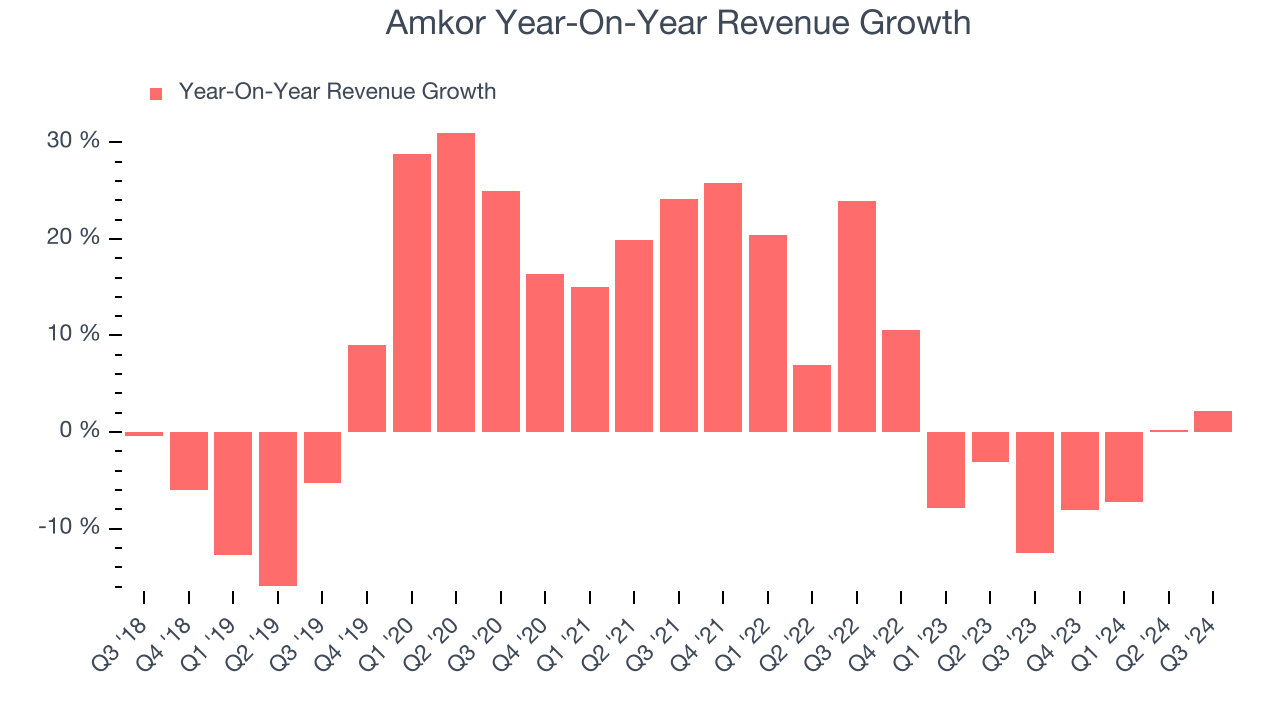
Semiconductor packaging and testing company Amkor Technology (NASDAQ: AMKR) reported Q3 CY2024 results topping the market’s revenue expectations, with sales up 2.2% year on year to $1.86 billion. On the other hand, next quarter’s revenue guidance of $1.65 billion was less impressive, coming in 10.5% below analysts’ estimates. Its GAAP profit of $0.49 per share was 1.7% below analysts’ consensus estimates.
Is now the time to buy Amkor? Find out by accessing our full research report, it’s free.
Amkor (AMKR) Q3 CY2024 Highlights:
- Revenue: $1.86 billion vs analyst estimates of $1.84 billion (1.2% beat)
- EPS: $0.49 vs analyst expectations of $0.50 (1.7% miss)
- EBITDA: $309 million vs analyst estimates of $316.4 million (2.3% miss)
- Revenue Guidance for Q4 CY2024 is $1.65 billion at the midpoint, below analyst estimates of $1.84 billion
- EPS (GAAP) guidance for Q4 CY2024 is $0.36 at the midpoint, missing analyst estimates by 34.1%
- Gross Margin (GAAP): 14.6%, in line with the same quarter last year
- Inventory Days Outstanding: 20, down from 28 in the previous quarter
- Operating Margin: 8%, down from 9.1% in the same quarter last year
- EBITDA Margin: 16.6%, down from 18.3% in the same quarter last year
- Free Cash Flow was -$31.33 million, down from $44.26 million in the same quarter last year
- Market Capitalization: $7.36 billion
“Amkor delivered third quarter revenue of $1.86 billion, up 27% sequentially, driven by strong demand for our Advanced SiP technology to support the Communications and Consumer end markets,” said Giel Rutten, Amkor’s President and CEO.
Company Overview
Operating through a largely Asian facility footprint, Amkor Technologies (NASDAQ: AMKR) provides outsourced packaging and testing for semiconductors.
Semiconductor Manufacturing
The semiconductor industry is driven by demand for advanced electronic products like smartphones, PCs, servers, and data storage. The need for technologies like artificial intelligence, 5G networks, and smart cars is also creating the next wave of growth for the industry. Keeping up with this dynamism requires new tools that can design, fabricate, and test chips at ever smaller sizes and more complex architectures, creating a dire need for semiconductor capital manufacturing equipment.
Sales Growth
A company’s long-term performance can give signals about its business quality. Even a bad business can shine for one or two quarters, but a top-tier one grows for years. Luckily, Amkor’s sales grew at a solid 10.2% compounded annual growth rate over the last five years. This is a useful starting point for our analysis. Semiconductors are a cyclical industry, and long-term investors should be prepared for periods of high growth followed by periods of revenue contractions.

Long-term growth is the most important, but recency is neccessary for semiconductors because of Moore's Law, which suggests the pace of technological innovation is so high that yesterday's hit new product could be obsolete today. Amkor’s recent history marks a sharp pivot from its five-year trend as its revenue has shown annualized declines of 3.5% over the last two years. 
This quarter, Amkor reported modest year-on-year revenue growth of 2.2% but beat Wall Street’s estimates by 1.2%. Management is currently guiding for a 5.8% year-on-year decline next quarter.
Looking further ahead, sell-side analysts expect revenue to grow 9.3% over the next 12 months, an improvement versus the last two years. This projection is above average for the sector and illustrates the market thinks its newer products and services will catalyze higher growth rates.
Unless you’ve been living under a rock, it should be obvious by now that generative AI is going to have a huge impact on how large corporations do business. While Nvidia and AMD are trading close to all-time highs, we prefer a lesser-known (but still profitable) semiconductor stock benefitting from the rise of AI. Click here to access our free report on our favorite semiconductor growth story.
Product Demand & Outstanding Inventory
Days Inventory Outstanding (DIO) is an important metric for chipmakers, as it reflects a business’ capital intensity and the cyclical nature of semiconductor supply and demand. In a tight supply environment, inventories tend to be stable, allowing chipmakers to exert pricing power. Steadily increasing DIO can be a warning sign that demand is weak, and if inventories continue to rise, the company may have to downsize production.

This quarter, Amkor’s DIO came in at 20, which is 10 days below its five-year average. At the moment, these numbers show no indication of an excessive inventory buildup.
Key Takeaways from Amkor’s Q3 Results
We were impressed by Amkor’s strong improvement in inventory levels. We were also glad its operating margin improved. On the other hand, its revenue and EPS guidance for next quarter missed analysts’ expectations, sending shares lower. Overall, this quarter could have been better. The stock traded down 12% to $25.95 immediately following the results.
Big picture, is Amkor a buy here and now?We think that the latest quarter is only one piece of the longer-term business quality puzzle. Quality, when combined with valuation, can help determine if the stock is a buy. We cover that in our actionable full research report which you can read here, it’s free.






